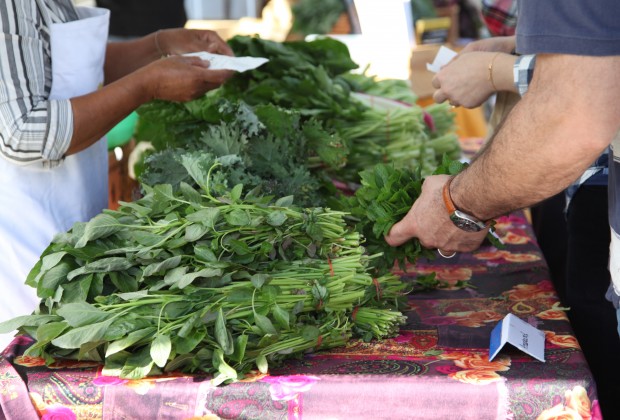“I brought some [greens] back for my dad, and he was eating it plain without salad dressing, he said it was good,” she recounts.
The Fresh Fund program helps families such as Kraut’s to stretch their food budgets so they have more room to shop for healthier food. The program's goal is to help low-income families buy accessible, affordable, nutritious produce. Offering matching dollars for produce appears to influence people's diets.
“People come out and try things they may not be used to, and they understand this produce tastes so much better than what they can get at the corner store,” said Troy McKinney, coordinator of Fresh Fund.
At the El Cajon Farmers’ Market, eligible families may collect up to $30 over a two months. At another market, in San Diego’s City Heights neighborhood, people get up to $90 over three months.
Organizers acknowledge that there are some limitations to the program because participants only have a two or three-month period to be part of it. The goal is that once families try out the farmers’ market they will keep coming back.
“We’re hoping that in that short period of time, they’ll come out here … they’ll try the produce, and they’ll choose to budget farmers’ market produce" into their regular shopping McKinney explained.
The International Rescue Committee, which provides services to refugees resettling in the United States, launched both the farmers’ markets and Fresh Fund as a way to expand access to healthier food for low-income families.
In 2008, IRC opened the market in City Heights, a low-income neighborhood and home to a large population of refugees from Southeast Asia, Africa and other parts of the world.
IRC staffers said the farmers’ market was a way to address challenges often faced by low to moderate-income families when it comes to eating healthy.
“Families don’t have to fall into the trap of buying calorie-rich but nutrient-deficient, cheap food,” said Ralph Achenbach, IRC’s Food and Farming Marketing Coordinator.
Refugees also find it difficult to cook native dishes without access to fruits and vegetables they traditionally use, said Achenbach. At the City Heights Farmers’ Market, some of the vendors include refugees who are trained by IRC to grow and sell produce found in their home countries.
“Some of the African farmers are growing African amaranth or cassava, or things you don't necessarily find in other farmer's market,” said Achenbach.
McKinney said El Cajon was chosen as the site for the newest farmers’ market because many of IRC’s clients, including Iraqi refugees, have resettled in the area.
“We want to make sure that our clients and the community, have access to this quality produce, which we think is really the highest quality produce you can buy in San Diego or in any other neighborhood,” said McKinney.
Mayce Kadhum is from Iraq and recently moved to El Cajon in the beginning of 2013. She said she appreciates the produce available at the farmers’ market because she is unable to plant her own vegetables.
“Someone told me to plant something,” Kadhum said. “The problem is, I don't have enough space in my flat. This is the problem.”
Fresh Fund organizers said they have seen the program improve the lives of participants.
Of participants surveyed, more than 95 percent said they have increased or greatly increased both the amount and variety of fruits and vegetables they eat.
